Exploring your first guitar purchase? The world of stringed instruments offers many options, often overwhelming newcomers. To ease your selection process, we’ve compiled a comprehensive guide to the various guitar types you’ll encounter.
Whether you’re drawn to the refined tones of steel-string dreadnoughts or the edgy allure of heavy metal machines, we’re here to help you find your ideal instrument.
TYPES OF GUITAR – WHAT ARE THEY?
Delving into the realm of guitars opens doors to a universe of musical possibilities. These versatile instruments have charmed musicians and audiences alike for centuries, with their diverse sounds and rich histories. From the elegant curves of acoustic guitars to the electrifying presence of electric models, each type offers a unique experience.
Whether you’re a seasoned player or embarking on your musical journey, understanding the nuances of guitars is essential. Join us as we explore the fascinating world of guitars, uncovering their evolution, characteristics, and enduring appeal.
Read More: The Head and the Heart Albums
CLASSICAL GUITARS
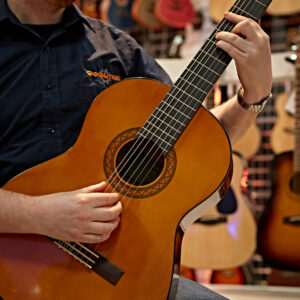
From the graceful melodies of flamenco to the grandeur of classical symphonies, the classical guitar stands as an emblem of responsive fingerpicking and its signature warm nylon timbre.
Typically smaller than other acoustic counterparts, classical guitars produce a bright tone ideal for accentuating individually plucked notes within a mix. Crafted from various materials, they consistently feature nylon strings, offering ease of fretting and gentleness on uncalloused hands.
Their wide, flat radius fretboards facilitate effortless fingerstyle playing, providing ample space for precise note articulation. Moreover, many scaled-down classical guitars cater to budding musicians, ensuring accessibility for younger students venturing into the musical realm.
While versatile for strumming chords, classical guitars may lack the mid-range and low-end resonance favored in singer-songwriter genres. However, instruments like the Deluxe Cutaway Classical Electro Guitar by Gear4Music present an exceptional all-around option, boasting full size, a cutaway neck for high-fret accessibility, and integrated electronics for seamless performance and recording.
In summary, classical guitars’ comfortable nylon strings, compact size, and expansive fretboard make them ideal starting points for novice players. With abundant affordable, beginner-friendly options available, embarking on your musical journey has never been more accessible.
STEEL-STRING ACOUSTICS
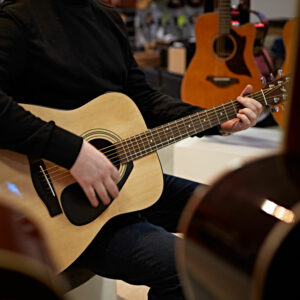
When it comes to acoustic guitars, the iconic dreadnought style often springs to mind. Steel strings have remained a staple in popular music for over a century, adapting to suit each new wave of musicians.
Steel-string acoustic guitars come in various shapes and sizes, which significantly influence their sound characteristics. The renowned dreadnought style, originating from Martin in the 1930s, stands out with its robust voice and ample volume, making it a perennial favorite.
Beyond the dreadnought, there’s the spacious jumbo, the vibrant parlor, and the versatile concert shape. These guitars can be crafted from various tonewoods, with mahogany or rosewood backs and sides paired with spruce tops being common combinations.
In discussions about acoustic guitars, you’ll encounter mentions of solid and laminate woods. Solid wood guitars, though pricier, offer a richer tone that matures over time, while laminate guitars provide affordability and durability, making them ideal for beginners on the go.
Renowned for their balanced tones, steel-string guitars are beloved by singer-songwriters for their ability to deliver detailed, full-bodied chords. Whether you’re an aspiring artist or a blues enthusiast, the Yamaha F310 presents an excellent entry point, boasting remarkable versatility to tackle chords and intricate finger-picked melodies.
RESONATOR GUITARS

Resonator guitars often fly under the radar for guitar newcomers, yet they carve out a unique niche with their distinct style and twangy resonance. Originating in the 1920s, their funky design and metallic construction emerged as a response to big bands’ overpowering horns and percussion, outshining traditional wooden acoustic guitars.
Innovator John Dopyera tackled this sonic challenge head-on, pioneering the first resonator guitar with its metal bridge and resonator cones, which replaced the conventional wooden soundboard. This breakthrough resulted in significantly amplified volume and a characteristic treble tone, setting resonators apart from their acoustic counterparts.
Following his initial success, Dopyera founded Dobro to continue refining resonators, a name that has become synonymous with the instrument itself. Today, when exploring resonator guitars, you’ll often encounter the term “Dobro” used interchangeably.
Resonators manifest in two primary styles: round-necked and flat/square-necked. Round-necked resonators function similarly to standard acoustic guitars, utilizing standard E tuning while delivering their mesmerizing metallic timbre. In contrast, square-necked resonators are exclusively played flat on the lap due to their neck shape and elevated nut and string action.
As for musical genres, lap steel guitars are predominantly featured in country and bluegrass styles, serving as slide instruments. On the other hand, round-necked resonators find their place in country, bluegrass, and blues, thanks to their versatile guitar action that facilitates exploration across various genres.
For those intrigued by resonators, the Hartwood Renaissance Resonator is an excellent starting point. Featuring quality components like a bone nut, steel alloy construction, and a biscuit-style resonator, it delivers a sparkling, twangy tone that captivates any curious guitarist.
ELECTRO-ACOUSTIC GUITARS
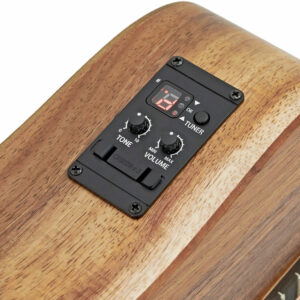
Enter the realm of electro-acoustic guitars, identical to their acoustic counterparts but with a game-changing addition: the ability to plug into amplifiers for amplified sound.
This innovation resolves the challenge of relying on microphones to amplify acoustic guitars, a method not always feasible or convenient. Electro-acoustics emerged as the go-to choice for gigging and recording musicians, offering seamless integration with PA systems, DI boxes, or amplifiers, ensuring their sound reaches every audience corner.
So, how do they function? Electro-acoustic guitars incorporate a pickup and preamp to convert acoustic tones into electronic signals. The pickup captures the guitar’s sound, while the preamp enables tone shaping through an EQ.
Pickups vary in design, each offering a distinct sonic character:
1. Piezo: Utilizes a strip of magnets beneath the saddle or bridge.
2. Microphone: Features a small microphone integrated inside the guitar.
3. Soundhole mounted: Positions a flat pickup across the soundhole, akin to solid-body electric guitars.
Most electro-acoustics adopt the piezo style for its discreet nature and reduced feedback susceptibility. However, like traditional acoustics, the price range for electro-acoustics spans from beginner-friendly options to premium luthier-crafted instruments boasting state-of-the-art electronics.
This broad selection caters to players of all levels, with many models incorporating onboard tuners for added convenience, whether for beginners or seasoned performers.
For those seeking an instrument with a commanding presence and user-friendly electronics, the Sigma GJME Grand Jumbo Electro-Acoustic warrants attention. Featuring a jumbo-style body for robust volume and tonal depth, coupled with Sigma’s intuitive electronics, it delivers a powerful performance, whether plugged in or not!
SEMI-HOLLOW OR HOLLOW-BODY GUITARS
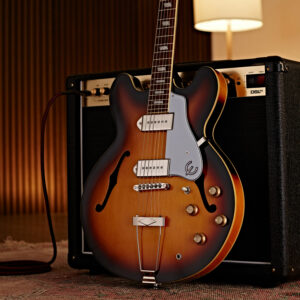
Sitting at the intersection of acoustic and solid-body electric guitars, semi-hollow and fully hollow-body guitars boast large, gracefully curved bodies housing resonant sound chambers and electric guitar-style pickups.
Distinctive features shared by a semi and fully-hollow-body guitars include F holes, an archtop body, and adjustable tailpieces.
Semi-hollow vs. hollow-body:
As the name implies, hollow-body guitars are predominantly hollow. They yield expansive, full-bodied tones with remarkable clarity and a lush acoustic resonance, making them particularly well-suited to clean jazz and blues genres.
However, one drawback of fully hollow bodies is the potential for feedback at higher volumes, which can compromise their pristine sound. This challenge is addressed by the semi-hollow design, featuring a center block running through the middle to mitigate feedback, enabling them to handle higher gain levels for crunchy and distorted tones.
Consequently, the sonically versatile semi-hollow design enjoys greater popularity, as it can seamlessly adapt to modern rock, blues, and pop styles while maintaining clarity. The iconic Lucille ES-355, associated with BB King, epitomizes the archtop semi-hollow guitar—so iconic, in fact, it was stolen multiple times!
On the other hand, the fully hollow Epiphone Casino, famously wielded by John Lennon, remains highly coveted for its thinline construction, which reduces feedback and exudes a distinctively stylish aura.
For those intrigued by the archtop aesthetic and rich tonality, the Epiphone ES-339 is an excellent entry point. Its semi-hollow construction and potent humbucker pickups deliver clarity for clean jazz, classic crunch for blues, and enhanced output capability for rock ‘n’ roll.
SOLID-BODY ELECTRIC GUITARS
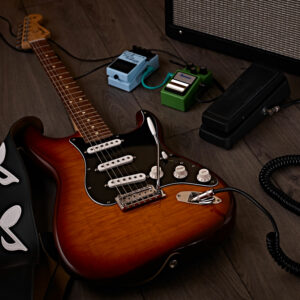
Symbolizing the essence of 20th-century music, solid-body electric guitars are synonymous with the genre-defining sound of rock.
From the legendary Jimi Hendrix of the ’60s to the contemporary virtuosos like Polyphia, solid body electrics have been wielded by generations of famous artists who have not only played them but also pushed the boundaries of musical genres, ensuring their presence in various modern forms of music.
In contrast to acoustics and hollow-body electrics, the tone of solid-body electric guitars predominantly emanates from the pickups—block-like magnets covering each string, available in many varieties, profoundly shaping the expected tonal outcome.
Furthermore, the neck shape varies based on guitar type, catering to specific player preferences. Shredder guitars aimed at fast-paced metal enthusiasts feature super-thin necks for rapid solos, while larger jazz instruments boast thicker necks for effortless chord playing.
Regarding sound versatility, the possibilities are endless! As electric signals are produced, tone modification through effect pedals ranges from gentle overdrives to otherworldly digital delays and reverbs.
The Fender Stratocaster, an emblematic guitar, epitomizes the essence of the earliest versions with its Vintera ’60s model. It is the quintessential instrument for rock, blues, and beyond, featuring a cool period appearance and sparkling, glassy tones.
Transitioning to bass guitars, they inherit the extended legacy of electric innovation. Conceived by Leo Fender in the ’50s to address the issue of acoustic double basses being drowned out in bands, electric bass guitars offer enhanced flexibility in tone projection.
With pickups akin to electric guitars, electric basses span a spectrum from vintage-style pickups to high-output humbuckers, catering to diverse tonal preferences.
The Fender Player Precision Bass (‘P bass’) is an iconic 4-string instrument, renowned for its ease of play and versatility across classic genres, from disco to indie rock. On the other hand, the Ibanez SRMD200D presents an affordable option for newcomers seeking a bass with extended frequencies, equipped with two pickups for heavier styles.
7-STRING GUITARS
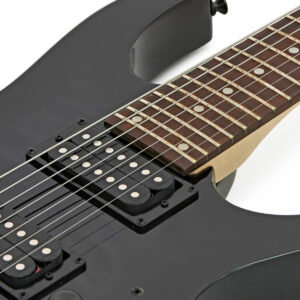
Dive deeper into sonic exploration with 7-string guitars, boasting an additional low B string to expand the instrument’s frequency range. This enhancement plunges your sound into thunderous bass depths, making them a prime choice for heavy genres like metal.
In metal, where dark tones and booming rhythms reign supreme, the added low end lends ferocious chugs an extra layer of menace. However, the versatility of 7-string guitars extends beyond metal; genres like jazz and jazz fusion capitalize on the broader sonic spectrum, crafting intricate chord shapes and richer bass rhythms.
Predominantly designed with metal in mind, 7-string guitars feature sleek bodies equipped with humbucking pickups and slender necks to accommodate the extra string. Furthermore, extended-range guitars often incorporate multi-scale fretboards, with slanted frets promoting a more ergonomic hand position for rapid solos.
But why stop at 7 strings? For those seeking even deeper tones and greater musical complexity, 8 and 9-string guitars offer further possibilities. Reserved for super technical virtuosos, these instruments push the boundaries of musical expression.
For aspiring metalheads venturing into the realm of 7-string guitars, the Ibanez GRG7221QA GIO presents a solid starting point. It boasts sturdy construction, powerful metal-ready pickups, a string-thru bridge for stable tuning, and a 5-way selector for a diverse range of tones. It’s an excellent choice to kickstart your musical journey.
12-STRING ACOUSTICS
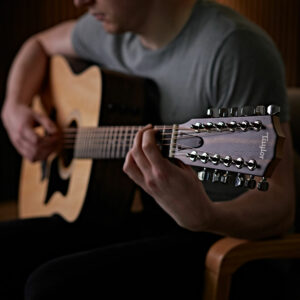
Radiating a sparkling and ethereal octave-rich resonance, 12-string acoustic guitars have left an indelible mark on music history, contributing to the iconic soundscapes of songs like “Hotel California,” “A Horse with No Name,” and “Wanted Dead or Alive.”
But why double the strings? Is it excessive? Not quite, as the strings are paired, allowing players to treat each couple as a single string. Thus, while the playing technique remains unchanged, the sound transforms. Each additional string is tuned an octave apart, resulting in a sweet, dynamically rich effect that elevates even basic chords into majestic, sweeping sounds.
So, why aren’t 12-strings recommended for beginners? Accommodating the extra strings and tension necessitates a wider and thicker neck, which can pose challenges for players still developing fretting hand strength. Additionally, maintenance tasks are doubled, with twelve strings to replace during restringing, and the significant change in tension often requires neck adjustments to maintain consistent playability.
However, despite these considerations, if the allure of the harmonically lush 12-string captivates you, the Fender CD-140SCE offers an enchanting sound without breaking the bank. Featuring a cutaway body for easy upper fret access and built-in electronics for simplified recording and live performances, it strikes a harmonious balance between affordability and sonic allure.
UKULELE
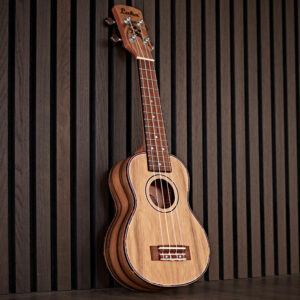
Compact, sonically vibrant, and irresistibly enjoyable, the ukulele beckons to both novice musicians and seasoned guitarists alike. Characterized by its petite guitar-like shape, typically adorned with four strings, the ukulele exudes a lively treble sound.
While its roots trace back to Europe, the ukulele has become synonymous with the idyllic paradise of Hawaii, embodying images of white sand beaches, azure ocean waters, and leisurely luaus. Experiencing a resurgence in popularity, the ukulele captivates enthusiasts with its affordability, ease of play, and social media appeal.
Though not native to Hawaii, the ukulele found a home there after locals were enamored by the small guitar brought by a traveling Portuguese musician. Dubbed “ukulele,” meaning “jumping flea,” for its nimble playability, it even captured the interest of the Hawaiian monarch, who embraced it.
Crafted akin to scaled-down acoustic guitars, ukuleles feature a variety of tonewoods, with budget-friendly options often employing laminate or plastic construction, while premium models boast solid wood craftsmanship. The instrument’s shape also influences its sound, with soprano ukuleles offering a bright voice, concert styles delivering a slightly larger and darker tone, tenor ukes featuring an extended scale length akin to guitars, and baritones producing an even deeper bass range.
Ukuleles are ideal for beginners due to their affordability, simplicity, and sing-along potential. They offer a gateway to musical exploration. The Luna Vintage Concert Uke, larger than a soprano, expands tonal options and incorporates built-in electronics, enabling you to amplify its gentle treble-rich voice for stage performances and beyond.
WEIRD ELECTRICS
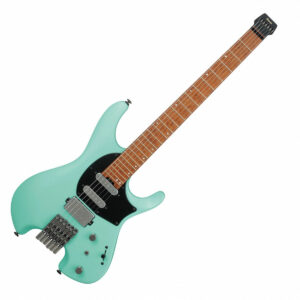
Exploring the realm of “weird guitars,” we delve into instruments that deviate from the standard six-string layout, offering unique features tailored to specific musical purposes. Here’s a breakdown of these unconventional creations:
Double-necked guitars, famously wielded by Led Zeppelin’s Jimmy Page, combine a 12-string and a standard 6-string into a single instrument. This fusion simultaneously grants access to enveloping octaval charm and standard electric guitar chops. However, they can be hefty and unwieldy, not for the faint of heart.
Extended-range and multi-scale guitars, an extension of the 7 strings we discussed, provide additional low-end frequencies for exploration. Ideal for heavy styles and creative virtuosos seeking to fully utilize the fretboard.
Headless guitars, exemplified by the Ibanez Q series, offer a distinctive appearance reminiscent of French revolutionary aesthetics. Despite their unconventional look, removing the headstock replaces the traditional nut with a zero fret, ensuring all notes are fretted seamlessly, akin to playing with a capo. This design enhances open-to-fretted note transitions, maintains even string tension, and improves intonation accuracy, while also facilitating easier string changes and reducing size and weight.
Baritone guitars, tailored for lower tunings, feature a longer scale length to retain string tension when tuning down for deeper pitches. Ideal for heavy styles that embrace drop tunings, baritone guitars find applications in diverse genres including surf rock, country, and jazz, showcasing their versatility across various guitar shapes and styles.
MORE ACOUSTICS
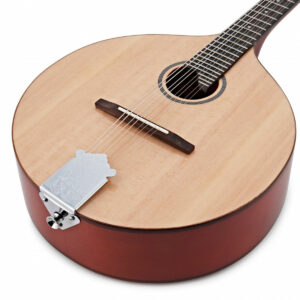
Concluding our guitar types guide, we delve into a selection of acoustic instruments often associated with the “folk” category:
Mandolin:
Compact and paired with strings similar to those of a 12-string acoustic guitar, mandolins produce a bright, treble-focused voice ideal for cutting through mixes.
Banjo:
Instantly evoking images of country music, the banjo boasts a sweet, jangly tone and rapid riff-ability, spanning genres from Dixieland jazz to modern rock.
Harp Guitar:
Blending a harp with a nylon-stringed acoustic, the harp guitar expands the instrument’s frequency range, delivering sweet, mellow tones and captivating soundscapes.
Lap Steel/Pedal Steel:
Offering alternative playing methods, lap steels lie flat on the lap, typically played with a slide or flat pick, while pedal steels are mounted on dedicated tables and feature small levers for changing the pitch while playing, allowing for a diverse range of sonic exploration.
HOW TO CHOOSE THE RIGHT STYLE FOR YOU
With so many guitar options, finding the right one for you might seem daunting. But fear not! The beauty of learning an instrument lies in the endless avenues of exploration. If a large acoustic guitar doesn’t strike your fancy, perhaps a sleek, rock-focused electric will ignite your passion!
The first step is to tune in to your favorite music and pinpoint the key sound you’re drawn to. Are you a fan of hard rock, blues, and distortion-rich genres? An electric guitar may be your perfect match. Do you adore the lively tones of bluegrass, country, or the twang of the banjo? Dive right in! Many banjo enthusiasts have never touched a standard guitar!
It’s crucial that your chosen guitar type aligns with both the sound and design of your preferred genre. Attempting to shred solos on a steel-string acoustic may prove challenging due to differences in neck shape, body size, and string material.
When it comes to acoustics, consider your budget and needs. Opting for an electro-acoustic guitar generally offers more versatility, providing expanded options for performance and recording.
Essentially, the right guitar type for you hinges on your preferred sound. So listen closely, explore fearlessly, and let your musical journey unfold!
Frequently Asked Questions
What are the main types of guitars?
The main types of guitars are acoustic, electric, classical, and bass guitars. Variations within these categories include 12-string guitars, semi-hollow body guitars, and baritone guitars.
What is the difference between acoustic and electric guitars?
Acoustic guitars produce sound acoustically through the vibration of the strings and resonance of the body, while electric guitars require amplification to produce sound, using pickups to capture string vibrations.
What genres are best suited for acoustic guitars?
Acoustic guitars are versatile and can be used across various genres, including folk, country, singer-songwriter, and acoustic rock.
Which genres typically use electric guitars?
Electric guitars are commonly used in genres like rock, metal, blues, jazz, and pop, where amplified sound and distortion effects are integral to the music.
What is a classical guitar?
Classical guitars are acoustic guitars with nylon strings, with a wider neck and fingerboard. They are primarily used in classical, flamenco, and traditional Spanish music.
What are some examples of specialty guitars?
Specialty guitars include double-necked guitars, 7-string guitars, lap steel guitars, and resonator guitars, each offering unique features tailored to specific musical styles and preferences.
Conclusion
Understanding the various types of guitars opens up a world of musical possibilities. Whether you’re drawn to the resonant tones of an acoustic guitar, the electrifying sound of an electric guitar, or the classical elegance of a nylon-string guitar, there’s a perfect instrument waiting for you.
From folk to rock, jazz to metal, each genre finds its voice through different guitar types, allowing musicians to express themselves uniquely. Whether you’re a beginner embarking on your musical journey or an experienced player looking to expand your sonic horizons, the diverse array of guitars offers something for everyone.
You can find the perfect guitar that resonates with your musical aspirations by considering your preferred genre, playing style, budget, and comfort level. And remember, the journey of discovering your ideal instrument is as rewarding as the music you create with it.

